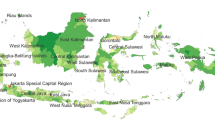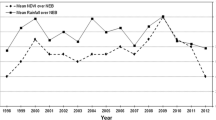Abstract
The Tibetan Plateau is a region sensitive to climate change, due to its high altitude and large terrain. This sensitivity can be measured through the response of vegetation patterns to climate variability in this region. Time series analysis of Normalized Difference Vegetation Index (NDVI) imagery and correlation analyses are effective tools to study land cover changes and their response to climatic variations. This is especially important for regions like the Tibetan Plateau, which has a complex ecosystem but lacks a lot of detailed in-situ observation data due to its remoteness, vastness and the severity of its climatic conditions. In this research a time series of 315 SPOT VEGETATION scenes, covering the period between 1998 and 2006, has been processed with the Harmonic ANalysis of Time Series (HANTS) algorithm in order to reveal the governing spatiotemporal pattern of variability. Results show that the spatial distribution of NDVI values is in agreement with the general climate pattern in the Tibetan Plateau. The seasonal variation is greatly influenced by the Asian monsoon. Interannual analysis shows that vegetation density (recorded here by the NDVI values) in the entire Tibetan Plateau has generally increased. Using a 1 km resolution land cover map from GLC2000, seven meteorological stations, presenting monthly data on near surface air temperature and precipitation, were selected for correlation analysis between NDVI and climate conditions in this research. A time lag response has also been found between NDVI and climate variables. Except in desert grassland (Shiquanhe station), the NDVI of all selected sites showed strong correlation with air temperature and precipitation, with variations in correlation according to the different land cover types at different locations. The strongest relationship was found in alpine and subalpine plain grass, the weakest in desert grassland.
Similar content being viewed by others
References
Azzali S, Menenti M (2000) Mapping vegetation-soil-climate complexes in southern Africa using temporal Fourier analysis of NOAA-AVHRR NDVI data. Int J Remote Sens 21(5):973–996
Cao M, Woodward FI (1998) Dynamic responses of terrestrial ecosystem carbon cycling to global climate change. Nature 393:249–252
Ding M, Zhang Y, Shen Z, Liu L, Zhang W, Wang Z, Bai W, Zheng D (2006) Land cover change along the Qinghai-Tibet Highway and Railway from 1981 to 2001. J Geogr Syst 16(4):387–395
Gurgel HC, Ferreira NJ (2003) Annual and interannual variability of NDVI in Brazil and its connections with climate. Int J Remote Sens 24(18):3595–3609
Holben B (1986) Characteristic of maximum value composite images for temporal AVHRR data. Int J Remote Sens 7:1417–1434
Immerzeel W, Quiroz R, Jong S (2005) Understanding precipitation patterns and land use interaction in Tibet using harmonic analysis of SPOT VGT-S10 NDVI time series. Int J Remote Sens 26(11):2281–2296
Julien Y, Sobrino JA, Verhoef W (2006) Changes in land surface temperatures and NDVI values over Europe between 1982 and 1999. Remote Sens Environ 103:43–55
Kaufmann RK, Zhou L, Myneni RB, Tucker CJ, Slayback D, Shabanov NV (2003) The effect of vegetation on surface temperature: a statistical analysis of NDVI and climate data. Geophys Res Lett 30(22):2147. doi:10.1029/2003GL018251
Liu X, Yin Z, Shao X, Qin N (2006) Temporal trends and variability of daily maximum and minimum, extreme temperature events, and growing season length over the eastern and central Tibetan Plateau during 1961–2003. J Geophys Res 111:D19109. doi:10.1029/2005JD006915
Ma Y, Zhong L, Su Z, Ishikawa H, Menenti M, Koike T (2006) Determination of regional distributions and seasonal variations of land surface heat fluxes from Landsat-7 enhanced thematic mapper data over the central Tibetan Plateau area. J Geophys Res 111:D10305. doi:10.1029/2005JD006742
Maisongrande P, Duchemin B and Dedieu G (2004) VEGETATION/SPOT: an operational mission for the Earth monitoring; presentation of new standard products. Int J Remote Sens 25(1):9–14
Menenti M, Azzali S, Verhoef W and van Swol R (1993) Mapping agroecological zones and time lag in vegetation growth by means of fourier analysis of time series of NDVI images. Adv Space Res 5:233–237
Myneni R, Keeling C, Tucker C, Asrar G, Nemani R (1997) Increased plant growth in the northern high latitudes from 1981 to 1991. Nature 386:698–702
Oku Y, Ishikawa H, Su Z (2007) Estimation of land surface heat fluxes over the Tibetan Plateau using GMS data. In: Journal of applied meteorology and climatology. J Appl Meteorol Clim 46(2):183–195
Piao S, Mohammat A, Fang J, Cai Q, Feng J (2006) NDVI-based increase in growth of temperate grasslands and its responses to climate changes in China. Glob Environ Change 16:340–348
Pielke RA, Avissar RI, Raupach M, Dolman AJ, Zeng X, Denning AS (1998) Interactions between the atmosphere and terrestrial ecosystems: influence on weather and climate. Glob Chang Biol 4:461–475
Rees M, Condit R, Crawley M, Pacala S, Tilman D (2001) Long-term studies of vegetation dynamics. Science 293:650–655
Roerink GJ, Menenti M, Soepboer W, Su Z (2003) Assessment of climate impact on vegetation dynamics by using remote sensing. Phys Chem Earth 28:103–109
Smith E, Shi L (1995) Reducing discrepancies in atmospheric heat budget of Tibetan Plateau by satellite-based estimates of radiative cooling and cloud-radiation feedback. Meteorol Atmos Phys 56:229–260
Su Z, Roerink G, Jacobs C (2001) Development of a procedure to produce time series of evaporation fractions. In: Su Z, Jacobs C (eds) Advanced earth observation—land surface climate. Publications of the Netherlands National Remote Sensing Board (BCRS)
Verhoef W (1996) Application of harmonic analysis of NDVI Time Series (HANTS). In: Azzali S, Menenti M (eds) Fourier analysis of temporal NDVI in the Southern African and American continents. Wageningens
Verhoef W, Kamp A, Koelemeijer R (2005) Climate indicators from time series of NDVI images (CITISEN). Report, National Aerospace Laboratory, NLR, The Netherlands
Wang B (2006) The Asian monsoon. Springer, New York
Wen J, Su Z (2004) An analytical algorithm for the determination of vegetation leaf area index from TRMM-TMI data. Int J Remote Sens 25(6):1223–1234
Wen J, Su Z, Ma Y (2004) Reconstruction of a cloud-free vegetation index time series for the Tibetan Plateau. Mt Res Dev 24(4):348–353
Xu J (2004) Mathematical method in contemporary geography. Higher Education Press, Beijing
Ye D, Gao Y (1979) Meteorology of the Qinghai-Xizang Plateau. Chinese Science Press, Beijing
You Q, Kang S, Pepin N, Yan Y (2008) Relationship between trends in temperature extremes and elevation in the eastern and central Tibetan Plateau, 1961–2005. Geophys Res Lett 35:L04704. doi:10.1029/2007GL032669
Zhang Q, Kang S, Yan Y (2006) Characteristics of spatial and temporal variations of monthly mean surface air temperature over Qinghai-Tibet Plateau. Chin Geogr Sci 16(4):351–358
Zhong L (2007) Ground measurement and satellite remote sensing of land surface characteristics parameters over the Tibetan Plateau area. Dissertation, Institute of Tibetan Plateau Research, Chinese Academy of Sciences
Zhou L, Tucker C, Kaufmann R, Slayback D, Shabanov N, Myneni R (2001) Variations in northern vegetation activity inferred from satellite data of vegetation index during 1981 to 1999. J Geophys Res 106(D17):20069–20083
Zhou D, Fan G, Huang R, Fang Z, Liu Y, Li H (2007a) Interannual variability of the normalized difference vegetation index on the Tibetan Plateau and its relationship with climate change. Adv Atmos Sci 24(3):474–484
Zhou R, Yang Y, Fang J (2007b) Responses of vegetation activity to precipitation variation on the Tibetan Plateau. Acta Scientiarum Naturalium Universitatis Pekinensis 43(6):771–775
Author information
Authors and Affiliations
Corresponding author
Rights and permissions
About this article
Cite this article
Zhong, L., Ma, Y., Salama, M.S. et al. Assessment of vegetation dynamics and their response to variations in precipitation and temperature in the Tibetan Plateau. Climatic Change 103, 519–535 (2010). https://doi.org/10.1007/s10584-009-9787-8
Received:
Accepted:
Published:
Issue Date:
DOI: https://doi.org/10.1007/s10584-009-9787-8




